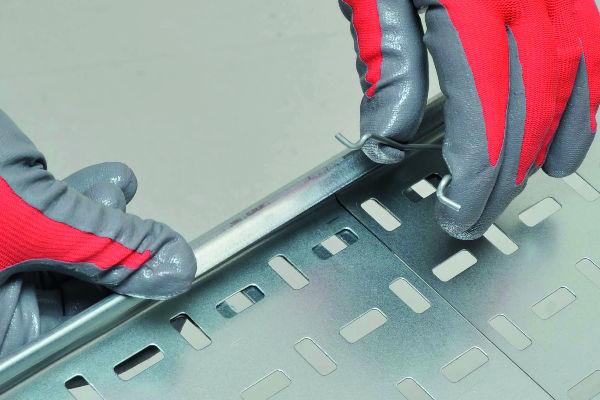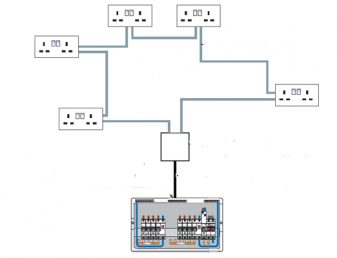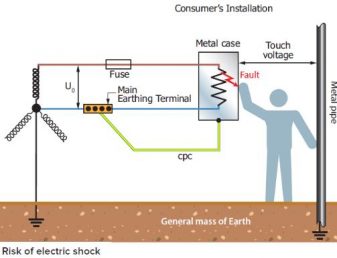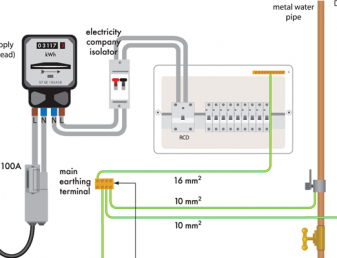There are a wide variety of containment systems available to organise and store cables within an installation. They tend not to be used exclusively for a particular type of wiring system, and the containment system chosen is often as much decided by the budget and practical considerations of the building it is being installed in as the cabling type itself.
Fixings in cable management
With such a range of cable management options available, ranging from lightweight cable trays through to heavy trunking, the choice of fixings for an installation needs to factor in both the weight of the cable management solution and the cables that it is carrying. Specialist advice must be taken from structural engineers on site, or the fixings manufacturers themselves on the weight the fixings can carry. In cases of heavy loads, anchor bolts or brackets may be used to secure things safely.
What is a cable tray system?
A cable tray system is a unit or set of units and fittings which form a rigid structure to secure or support electrical cables and raceways. It allows the safe transport of wires across open spaces and is effectively the structural component, or skeleton, of a building’s electrical system.
What types of cable management systems are there?
There are lots of different options for containment systems, depending on the types of cables and the building or area where the system is being installed. Some of the most common include:
- Cable baskets – lightweight and easily connected, these usually clip together making them quickly installed. They are often used for Category 5A and Category 6 TCP/IP data cabling, but can be used for many types of cable that have more than basic insulation. This includes PVC / PVC 6242Y, MICC, fireproof or steel wire armoured cables.

- Ladder racking and traywork – mostly used in industrial installations, as well as for MICC and other small soft-skinned cables. Ladder racking is for heavier cables, including armoured cables, because it is strong enough to withstand more weight than a cable basket.

What is a conduit system?
Electrical conduits are tubes used to protect and route wiring and come in a range of materials depending on the conditions of the installation – for example if it is situated somewhere damp, PVC or galvanised metal should be used. Conduits can be used for entire systems or single thermoplastic or XLPE cables with basic insulation, when they protect the cable’s insulation from damage and reduce the risk of faults.
Conduits are secured using saddles. As standard these tend to be spacer bar saddles, but distance saddles can be used to fix conduit to uneven surfaces, while hospital saddles – which have a thicker base – allow for easier cleaning around the conduit in places where hygiene is a concern.
Conduit systems also allow for wiring system ‘drops’ to yet-to-be-installed electrical equipment, meaning building work can be completed and the cables pulled into place later.
Lengths of conduit are connected by couplings. Where a conduit enters a box with no thread entry it is terminated by a coupling and a brass bush to complete the connection.
What is a running coupling?
If two systems can’t be screwed together a running coupling can be improvised, using two standard couplings, a nipple, a locknut and a length of extra-long threaded conduit. These are a potential area of weakness in the conduit and ideally avoided.
What is a trunking system?
Mostly used for single insulated cable, trunking can be bent and jointed into complex configurations, making it a versatile way to carry many different types of cables. Systems are available in a range of shapes and sizes. Conduit and trunking systems effectively act as parallel conductors, so standard earth fault loop impedance in trunking systems often ends up being less than calculated.

What is mini-trunking?
In installations with minimal amounts of cable (for example, smaller offices), mini-trunking can be used in place of larger PVC trunking. It often comes with a self-adhesive backing so can be fixed easily to a wall.
What is Dado trunking?
Dado trunking tends to be used in offices or buildings with a lot of data and power outlets. The trunking has multiple compartments, allowing telephone, power and data cables to be trunked together nearly but kept separate from each other. It is very versatile, allowing positions of outlets to be changed after installation if necessary.
What trunking regulations are there?
BS 7671 contains regulations relating to the use of trunking in electrical installations. These rules are that:
- Non-sheathed cables can be installed in a trunking system if it provides a protection level of at least IPXXD or IP4X and if the cover can only be removed by means of a wool or deliberate action.
- In the case of systems that include site-fabricated joints, the installer must confirm that these too, meet at least protection level IPXXD.
The introduction of these regulations had far-reaching consequences for the industry because traditionally IP30-rated trunking was used with single insulated cables.
What is an IP rating?
All trunking is given an Internal Protection (IP) rating. This denotes the degree of protection an enclosure provides against a range of external agents.
IP codes come in a format of up to four digits:
- First number: 0 to 6 or the letter X – this denotes the protection level of persons against access to hazardous parts inside enclosures.
- Second number: 0 to 8 or the letter X – this denotes the protection level of equipment against ingress, or access, by solid foreign objects.
- Optional additional letter 1: A, B, C or D – this denotes the protection of equipment against penetration by water.
- Optional supplementary letter 2: H, M, S or W – this denotes the level of protection against access to hazardous parts.
The additional letter is only used if the protection against access to hazardous parts is greater than that indicated by the first number.
P4X and IPXXD rated trunking systems offer a high degree of protection. IP4X systems must have an enclosure that offers full protection against solid foreign objects larger than 1mm. IPXXD enclosures have a similar level of protection, although the probe is allowed to enter the product as long as it does not touch any hazardous parts.






